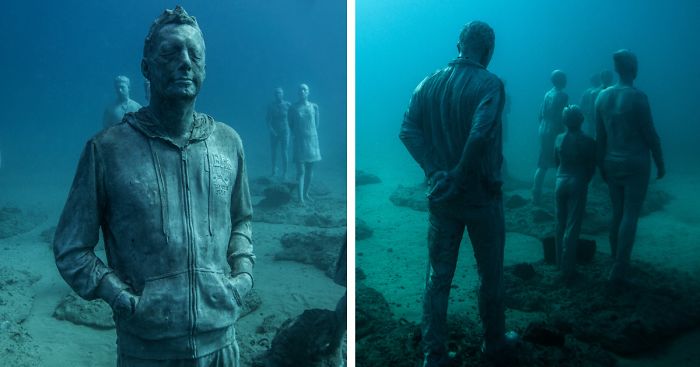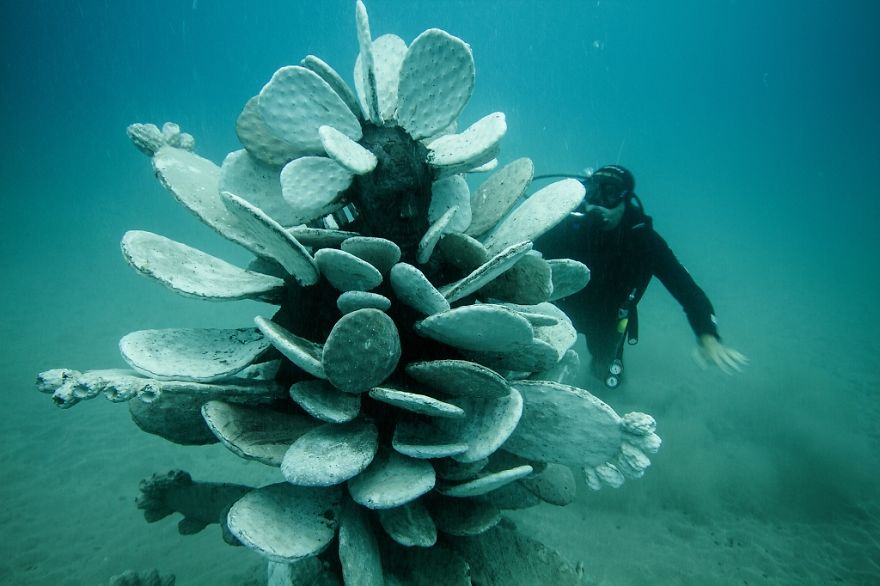
Breathtaking Underwater Museum Turns Ocean Floor Into Art Gallery And Doubles As Artificial Reef
Museo Atlantico, Europe’s first underwater contemporary art museum deployed the first phase of sculptures by internationally acclaimed sculptor Jason deCaires Taylor this February. Situated in clear blue waters off the coast of Lanzarote in the Canary Island, Spain, Museo Atlantico is a unique museum featuring a series of sculptural installations constructed 12m beneath the ocean’s surface. Accessible to snorkelers, divers and observers through glass bottom boats, the museum is due to be completed by December 2016 and will consist of ten underwater galleries.
The project, draws on the dialogue between art and nature, is designed on a conservational level to create a large scale artificial reef to aggregate local fish species and increase marine biomass. On the other hand, the work questions the commodification and delineation of the world´s natural resources and land masses raising awareness to current threats facing the world’s oceans. An extraordinary series of underwater artworks; concrete figures representing desperate refugees, selfie-taking tourists and fantastical hybrids of people and plants drawn from the flora and fauna of Lanzarote, over time the work will be transformed as they are slowly colonised by the local marine life.
The central concept of the Museo Atlantico is depicted by means of a monumental gateway and division that includes a series of installations based on the dialogue between past and present and the divisions between society with both political and social commentary. Referencing Lanzarote’s unique status as a UNESCO World Biosphere Reserve, the works will incorporate a large scale architectural installation and an underwater botanical sculpture garden featuring a variety of Lanzarote’s local species.
The Museum is constructed using environmentally friendly, pH neutral inert materials including a specially developed marine grade cement, stainless steel structures and fibre glass spun rebar. The formations of the sculptures are tailored to suit the endemic marine life, positioned in a bay with modest current marine colonization. The project will create a new habitat area for marine life whilst reaffirming Lanzarote as a modern, dynamic and cultural island celebrating its unique natural resources and will occupy an area of previously barren sand-covered sea bed 50m x 50m.
The museum will be the first underwater museum in Europe and the Atlantic Ocean and is designed to last for hundreds of years but will be an ever changing exhibition as marine life changes and transforms the surfaces of the sculptures. It opens to visitors at the end of February, with new galleries added throughout the year until the museum is completed by the end of 2016.
More info: underwatersculpture.com
Rubicon
Referencing ongoing divisions in society the Rubicon consists of a crowd of 35 human figures walking towards an underwater gateway; a boundary between two realities and a portal to the Atlantic Ocean. The sculptures are cast from the local community of the island of Lanzarote.
Photographers
The photographers intend to initiate a debate on the use of new technologies and voyeurism in today’s society.
The Hybrid
This is a cactus-man, a depiction of the Syrian refugee crisis and an underground botanical garden.
Raft of Lampedusa
A harrowing observation of the ongoing humanitarian crisis referencing Gericault’s painting. Representing the abandonment suffered by sailors in his shipwreck, the sculpture aims to draw a parallel from the controversial situation of the current refugee crisis, where many are abandoned by society or a lack of humanity: a reflection on hope and loss.
47Kviews
Share on Facebook


















375
22